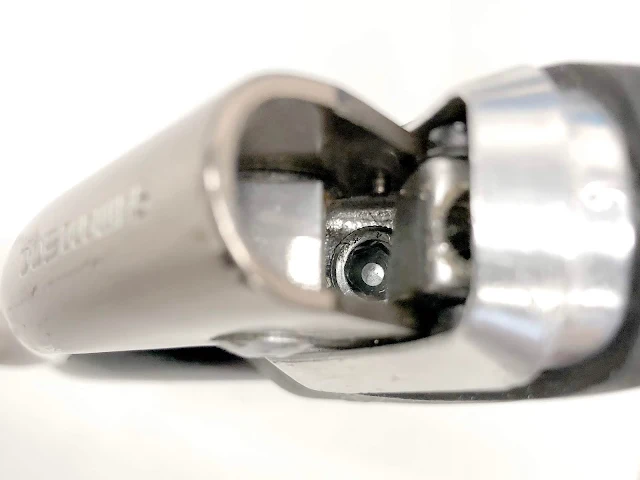Bought on Amazon for about $12. Came directly from Taiwan. The postage is about $4.50. No tax.


The piece on the very right (upper head tube race) goes between the two larger chrome pieces in the middle (it's out of order).
 |
| Tange is a Japanese brand & is the original manufacturer of the fork that came on the Paramount. This new headset came from Taiwan... |
 |
| The piece on the LH side (crown race) goes on the fork and the piece on the RH side (upper head tube race) goes on the top of the headtube... |
 |
The lower headtube race was hammered (soft face) into the bottom of the headtube. The interference fit is such that some gentle hits (many) with a soft face hammer can seat the race. Although it doesn't look like it, the race is fully seated. There's a slight curve to the top surface so that there's a slight gap at the edge but it's seated on the inner side...
|
 |
| Next is the install of the upper adjustable race (the bare headtube is ready). |
 |
| The upper headtube race is shallow and will not be visible once the upper adjustable race is installed on the fork. |
 |
| The crown race has been pressed (hammered) onto the fork. The interference fit was just right. |
 |
| Fully seated. |
 |
| Just placed the upper bearing and adjustable race in place to see how it will look... Need to grease the bearings before assembly to the fork. |
 |
| The lower bearing and seal, just placed to check the fit (OK). |
 |
| The black piece below the bearing is the seal to keep dirt out... |
 |
| Adjustable race, upper bearing & seal Before applying grease |
 |
| After grease (the one on the top right is the lower bearing). |
 |
| bearing seated in the upper adjustable race. |
 |
| Lower bearing placed on the fork stem. In this picture, the bearing is upside down. The bearing cage should point down, not up like this. I made this mistake & assembled it. When moving the fork, it wasn't as smooth as it should be. I took it back apart and realized my mistake & reassembled correctly. Afterwards, the steering feel was very smooth. |
 |
| The Upper adjustable race installed and tightened to the right amount of drag on the bearing. |
 |
| The lower headtube race, bearing, seal seated on the crown race (on the fork) |
 |
| The adjustable race, bearing & seal assembled to the fork & upper head tube race. |
 |
| Due to the length of the threaded portion of the fork, two washers were needed between the locknut and the adjustable race, to get the right fit to the seal on the locknut. The other option would have been to cut the top of the fork (the threaded portion) so that it's about 3 mm shorter. |
 |
| The headset fully assembled to the frame/headtube. The adjustable race & locknut were tightened so that there is no up/down play but the steering is still smooth and low effort. |
 |
| Installed the gooseneck (Quill stem) to the fork (with handlebar and brake levers). The front brake cable and hosing can be installed next... |




















































